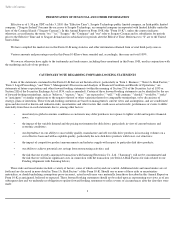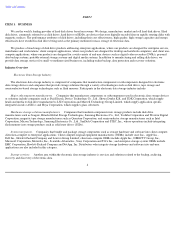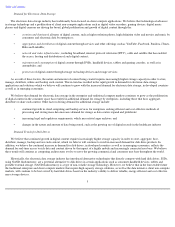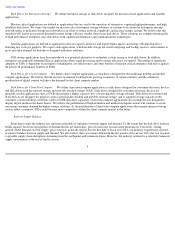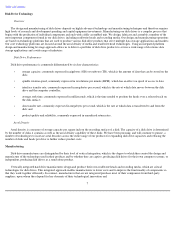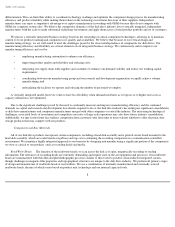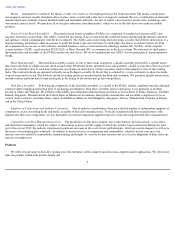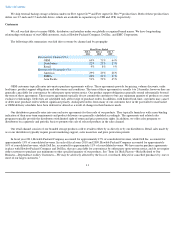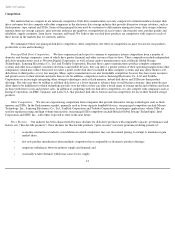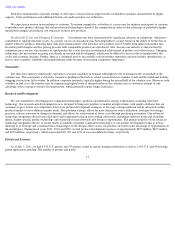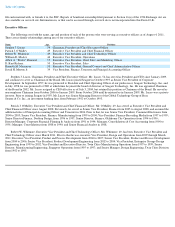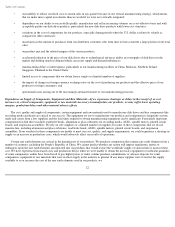Seagate 2010 Annual Report Download - page 16
Download and view the complete annual report
Please find page 16 of the 2010 Seagate annual report below. You can navigate through the pages in the report by either clicking on the pages listed below, or by using the keyword search tool below to find specific information within the annual report.
Table of Contents
Disk drive manufacturers typically attempt to offset price erosion with an improved mix of disk drive products characterized by higher
capacity, better performance and additional feature sets and/or product cost reductions.
We expect price erosion in our industry to continue. To remain competitive, we believe it is necessary for industry participants to continue
to introduce new product offerings that utilize advanced technologies ahead of the competition in order to take advantage of potentially higher
initial profit margins and reduced cost structures on these new products.
Product Life Cycles and Changing Technology. Our industry has been characterized by significant advances in technology, which have
contributed to rapid product life cycles. As a result, success in our industry has been dependent to a large extent on the ability to be the first-to-
market with new products, allowing those disk drive manufacturers who introduce new products first to benefit from improved product mix,
favorable profit margins and less pricing pressure until comparable products are introduced. Also, because our industry is characterized by
continuous price erosion, the existence of rapid product life cycles has necessitated quick achievement of product cost effectiveness. Changing
technology also necessitates on-going investments in research and development, which may be difficult to recover due to rapid product life
cycles and economic declines. Further, there is a continued need to successfully execute product transitions and new product introductions, as
factors such as quality, reliability and manufacturing yields become of increasing competitive importance.
Seasonality
The disk drive industry traditionally experiences seasonal variability in demand with higher levels of demand in the second half of the
calendar year. This seasonality is driven by consumer spending in the back-to-school season from late summer to fall and the traditional holiday
shopping season from fall to winter. In addition, corporate demand is typically higher during the second half of the calendar year. However, with
volatility in fuel costs, the industry may be experiencing higher levels of demand earlier in the calendar year as customers attempt to take
advantage of less expensive modes of transportation, which generally require longer lead times.
Research and Development
We are committed to developing new component technologies, products and alternative storage technologies, including solid state
technology. Our research and development focus is designed to bring new products to market in high volume, with quality attributes that our
customers expect, before our competitors. Part of our product development strategy is to leverage a design platform and/or subsystem within
product families to serve different market needs. This platform strategy allows for more efficient resource utilization, leverages best design
practices, reduces exposure to changes in demand, and allows for achievement of lower costs through purchasing economies. Our advanced
technology integration effort focuses disk drive and component research on recording subsystems, including read/write heads and recording
media, market-specific product technology and technology focused towards new business opportunities. The primary purpose of our advanced
technology integration effort is to ensure timely availability of mature component technologies to our product development teams as well as
allowing us to leverage and coordinate those technologies in the design centers across our products in order to take advantage of opportunities in
the marketplace. During fiscal years 2011, 2010 and 2009, we had product development expenses of approximately $875 million, $877 million
and $953 million, respectively, which represented 8%, 8% and 10% of our consolidated revenue, respectively.
Patents and Licenses
As of July 1, 2011, we had 4,370 U.S. patents and 553 patents issued in various foreign jurisdictions as well as 1,093 U.S. and 444 foreign
patent applications pending. The number of patents and patent
13


